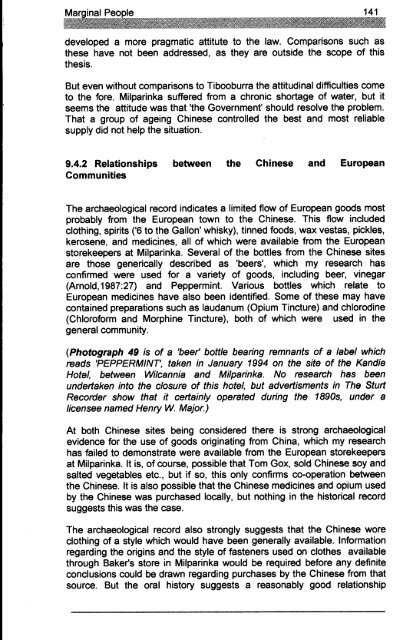Adec Preview Generated PDF File - The Sydney eScholarship ...
Adec Preview Generated PDF File - The Sydney eScholarship ...
Adec Preview Generated PDF File - The Sydney eScholarship ...
Create successful ePaper yourself
Turn your PDF publications into a flip-book with our unique Google optimized e-Paper software.
developed a more pragmatic attitute to the law. Comparisons such as<br />
these have not been addressed, as they are outside the scope of this<br />
thesis.<br />
But even without comparisons to Tibooburra the attitudinal difficulties come<br />
to the fore. Milparinka suffered from a chronic shortage of water, but it<br />
seems the attitude was that 'the Government' should resolve the problem.<br />
That a group of ageing Chinese controlled the best and most reliable<br />
supply did not help the situation.<br />
9.4.2 Relationships between the Chinese and European<br />
Communities<br />
<strong>The</strong> archaeological record indicates a limited flow of European goods most<br />
probably from the European town to the Chinese. This flow included<br />
clothing, spirits ('6 to the Gallon' whisky), tinned foods, wax vestas, pickles,<br />
kerosene, and medicines, all of which were available from the European<br />
storekeepers at Milparinka. Several of the bottles from the Chinese sites<br />
are those generically described as 'beers', which my research has<br />
confirmed were used for a variety of goods, including beer, vinegar<br />
(Arnold,1987:27) and Peppermint. Various bottles which relate to<br />
European medicines have also been identified. Some of these may have<br />
contained preparations such as laudanum (Opium Tincture) and chlorodine<br />
(Chloroform and Morphine Tincture), both of which were used in the<br />
general community.<br />
(Photograph 49 is of a 'beer' bottle bearing remnants of a label which<br />
reads 'PEPPERMINT', taken in January 1994 on the site of the Kandie<br />
Hotel, between Wilcannia and Milparinka. No research has been<br />
undertaken into the closure of this hotel, but advertisments in <strong>The</strong> Sturt<br />
Recorder show that it certainly operated during the 1890s, under a<br />
licensee named Henry W Major.)<br />
At both Chinese sites being considered there is strong archaeological<br />
evidence for the use of goods originating from China, which my research<br />
has failed to demonstrate were available from the European storekeepers<br />
at Milparinka. It is, of course, possible that Tom Gox, sold Chinese soy and<br />
salted vegetables etc., but if so, this only confirms co-operation between<br />
the Chinese. It is also possible that the Chinese medicines and opium used<br />
by the Chinese was purchased locally, but nothing in the historical record<br />
suggests this was the case.<br />
<strong>The</strong> archaeological record also strongly suggests that the Chinese wore<br />
clothing of a style which would have been generally available. Information<br />
regarding the origins and the style of fasteners used on clothes available<br />
through Baker's store in Milparinka would be required before any definite<br />
conclusions could be drawn regarding purchases by the Chinese from that<br />
source. But the oral history suggests a reasonably good relationship




